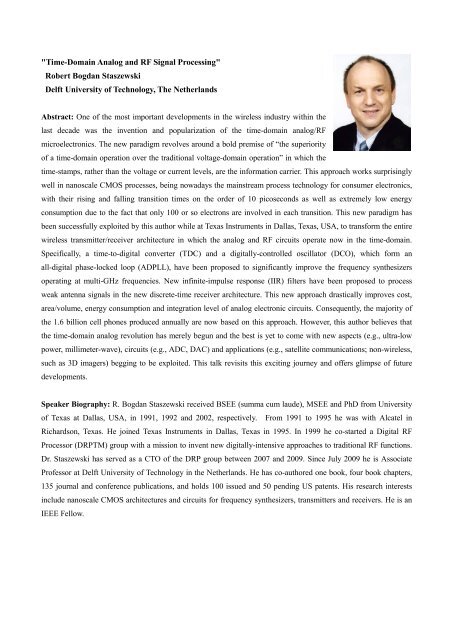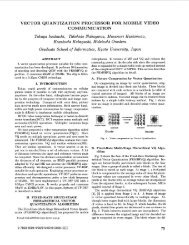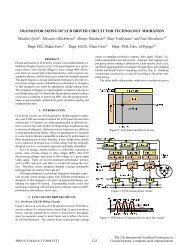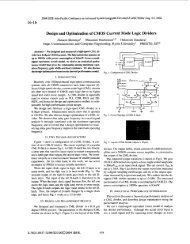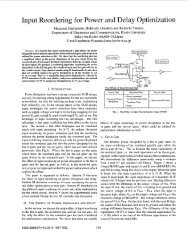RF Channel Filtering: a Revival of N-Path Filters in Nanometer CMOS?
RF Channel Filtering: a Revival of N-Path Filters in Nanometer CMOS?
RF Channel Filtering: a Revival of N-Path Filters in Nanometer CMOS?
Create successful ePaper yourself
Turn your PDF publications into a flip-book with our unique Google optimized e-Paper software.
"Time-Doma<strong>in</strong> Analog and <strong>RF</strong> Signal Process<strong>in</strong>g"Robert Bogdan StaszewskiDelft University <strong>of</strong> Technology, The NetherlandsAbstract: One <strong>of</strong> the most important developments <strong>in</strong> the wireless <strong>in</strong>dustry with<strong>in</strong> thelast decade was the <strong>in</strong>vention and popularization <strong>of</strong> the time-doma<strong>in</strong> analog/<strong>RF</strong>microelectronics. The new paradigm revolves around a bold premise <strong>of</strong> “the superiority<strong>of</strong> a time-doma<strong>in</strong> operation over the traditional voltage-doma<strong>in</strong> operation” <strong>in</strong> which thetime-stamps, rather than the voltage or current levels, are the <strong>in</strong>formation carrier. This approach works surpris<strong>in</strong>glywell <strong>in</strong> nanoscale <strong>CMOS</strong> processes, be<strong>in</strong>g nowadays the ma<strong>in</strong>stream process technology for consumer electronics,with their ris<strong>in</strong>g and fall<strong>in</strong>g transition times on the order <strong>of</strong> 10 picoseconds as well as extremely low energyconsumption due to the fact that only 100 or so electrons are <strong>in</strong>volved <strong>in</strong> each transition. This new paradigm hasbeen successfully exploited by this author while at Texas Instruments <strong>in</strong> Dallas, Texas, USA, to transform the entirewireless transmitter/receiver architecture <strong>in</strong> which the analog and <strong>RF</strong> circuits operate now <strong>in</strong> the time-doma<strong>in</strong>.Specifically, a time-to-digital converter (TDC) and a digitally-controlled oscillator (DCO), which form anall-digital phase-locked loop (ADPLL), have been proposed to significantly improve the frequency synthesizersoperat<strong>in</strong>g at multi-GHz frequencies. New <strong>in</strong>f<strong>in</strong>ite-impulse response (IIR) filters have been proposed to processweak antenna signals <strong>in</strong> the new discrete-time receiver architecture. This new approach drastically improves cost,area/volume, energy consumption and <strong>in</strong>tegration level <strong>of</strong> analog electronic circuits. Consequently, the majority <strong>of</strong>the 1.6 billion cell phones produced annually are now based on this approach. However, this author believes thatthe time-doma<strong>in</strong> analog revolution has merely begun and the best is yet to come with new aspects (e.g., ultra-lowpower, millimeter-wave), circuits (e.g., ADC, DAC) and applications (e.g., satellite communications; non-wireless,such as 3D imagers) begg<strong>in</strong>g to be exploited. This talk revisits this excit<strong>in</strong>g journey and <strong>of</strong>fers glimpse <strong>of</strong> futuredevelopments.Speaker Biography: R. Bogdan Staszewski received BSEE (summa cum laude), MSEE and PhD from University<strong>of</strong> Texas at Dallas, USA, <strong>in</strong> 1991, 1992 and 2002, respectively. From 1991 to 1995 he was with Alcatel <strong>in</strong>Richardson, Texas. He jo<strong>in</strong>ed Texas Instruments <strong>in</strong> Dallas, Texas <strong>in</strong> 1995. In 1999 he co-started a Digital <strong>RF</strong>Processor (DRPTM) group with a mission to <strong>in</strong>vent new digitally-<strong>in</strong>tensive approaches to traditional <strong>RF</strong> functions.Dr. Staszewski has served as a CTO <strong>of</strong> the DRP group between 2007 and 2009. S<strong>in</strong>ce July 2009 he is AssociatePr<strong>of</strong>essor at Delft University <strong>of</strong> Technology <strong>in</strong> the Netherlands. He has co-authored one book, four book chapters,135 journal and conference publications, and holds 100 issued and 50 pend<strong>in</strong>g US patents. His research <strong>in</strong>terests<strong>in</strong>clude nanoscale <strong>CMOS</strong> architectures and circuits for frequency synthesizers, transmitters and receivers. He is anIEEE Fellow.


